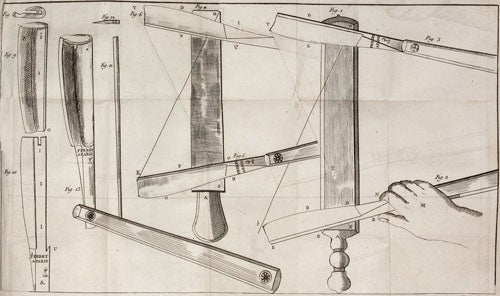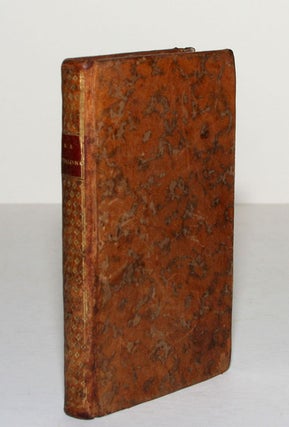La Pogonotomie, ou l’art d’apprendre a se raser soi-meme, avec la maniere de connoitre toutes sortes de pierres propres a affiler tous les outils ou instruments.
8vo [16 x 9.8 cm], 8vo [16 x 9.8 cm], xiv (i.e. xxiv) pp., (2) ff., 197 pp., (3) ff., with two large folding plates. Bound in contemporary mottled calf, spine gold tooled with diamonds, gold-tooled red title label laid to spine, board edges gold tooled, marbled endpapers, marbled edges. Boards somewhat scuffed, very minor worming, endpapers dusty. Owner inscription on front flyleaf (Antoine Seguin) small tears at joins of plates, number 72 written on title page, otherwise internally very clean.
Rare first edition of this landmark in the history of personal hygiene. Perret, a barber-surgeon, is commonly credited with having invented the first safety razor, appearing both in print and pictured for the first time in the present work. Being clean shaven was a mark of respectability in Enlightenment Paris, yet the practice of shaving oneself with a cut-throat razor was so dangerous that it was wisest to entrust the ritual to a barber-surgeon. Perret’s novel razor design, however, encouraged the masses to take up this mark of respectability, making a cheap and above all safe model widely available to the public.
As he reveals in his preface, however, the ‘art of shaving’ was in the 1760s far from the cosmetic preoccupation it would later become in the ‘Age of the Dandy.’ Instead, wary of blood-borne diseases, Parisians feared for their lives at every trip to the barber-shop. Perret’s personal razor, designed to be used only by its owner, thus became a medical necessity for diminishing the risk of infection. La Pogonotomie is divided into ten chapters: foundational remarks on the razor blade and its maintenance, the leather grip, and the nature of the beard are followed by chapters describing Perret’s newly-invented personal safety razor, with its correct use illustrated on the two folding plates. From Perret’s perspective as a professional barber-surgeon in the mid 18th century, shaving is a not an activity to be taken lightly, but a dangerous operation de pogonotomie which carries inherent and often severe risks.
These risks, seldom considered today, are outlined in the lengthy preface, in which Perret attempts to convince his readers that diseases, including “shameful” (i.e. venereal) infections are transmitted by the barber’s blade. To those who doubt this method of transmission Perret singles out smallpox inoculation as an example of the indubitable transfer of disease by blood. If one happens to be shaved by the same instruments used on a syphilitic or smallpox-ridden customer, one will often contract his disease. “What a travesty for people of a sound constitution, healthy in skin and blood, to have to run such risks!” (viii).
Perret’s personal razor effectively obviated this risk, as well as minimized the risk of cutting oneself. The device consisted of a normal blade with a custom-fit guard, allowing only the tip of the razor’s edge to protrude and thus limiting the depth to which it could cut.
The risk of infection diminished thanks to Perret’s design, shaving (and personal razors) surged in popularity during subsequent decades. Plate 1 reveals that Perret attempted to brand his invention by incising his name on the handle of his razor; unfortunately for him, by 1787 a M. Lethien of Paris was manufacturing his own safety razor, and mass-produced models would soon arrive in Germany and England.
OCLC lists copies at the NLM, Getty, Harvard, Penn, Columbia and NYPL. The 1770 second edition it held by Yale, Harvard, Nebraska, and Dartmouth.
* Blake 344; cf eg Peterkin, One Thousand Beards: A Cultural History of Facial Hair (2001)
Price: $1,850.00


